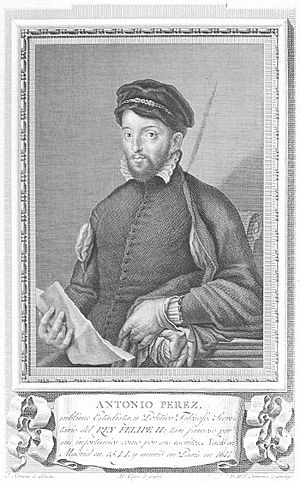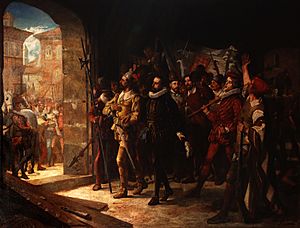Antonio Pérez (statesman) facts for kids

Antonio Pérez (1534–1611) was an important Spanish statesman and secretary to Philip II of Spain, one of Spain's most powerful kings. He is mostly remembered for his involvement in the murder of Juan de Escobedo. After this event, attempts to bring Pérez to justice led to big problems and riots. He eventually escaped from prison with help from his supporters and spent most of his later life in France.
Contents
Antonio Pérez: A Royal Secretary
Early Life and Education
Antonio Pérez was born in Madrid in 1534. In 1542, he was officially recognized as the son of Gonzalo Pérez, who was the Secretary of the Council of State for King Charles I of Spain. Even though Antonio was born in Madrid, he felt a strong connection to Aragon, where his father's family was very influential. Later, he would seek safety there from the king.
Antonio grew up in Val de Concha, a place connected to Ruy Gomez de Silva, the Prince of Eboli. The Prince was a leader of one of the main political groups at the time. Antonio went to top universities like Alcalá de Henares, Salamanca, and Leuven. His father taught him a lot about how the government worked.
Becoming a Royal Secretary
In 1543, Antonio's father, Gonzalo Pérez, became secretary to Prince Philip. When Charles V gave up his Spanish kingdoms in 1556, Philip became King Philip II. Gonzalo Pérez continued as his secretary. After Gonzalo died in 1566, Antonio became the Secretary of State for Castile a year later.
For his first ten years as secretary, Antonio Pérez had a lot of influence over King Philip. The king valued his advice. When the Prince of Eboli died in 1573, Antonio Pérez became the leader of that political group, working with the Prince's widow, Ana de Mendoza, the Princess of Éboli. In 1567, Antonio Pérez married Juana de Coello, and they had several children.
The Escobedo Murder Mystery
Antonio Pérez is most famous for his part in the murder of Juan de Escobedo. Escobedo was the secretary of Don Juan of Austria, who was King Philip's half-brother. King Philip was suspicious of Don Juan's plans. Antonio Pérez used this suspicion to his own advantage.
In 1575, Pérez suggested to the king that Escobedo should become Don Juan's secretary. Pérez thought Escobedo would spy for him. However, Escobedo became loyal to Don Juan instead. Antonio Pérez then started making King Philip suspicious of Escobedo. Pérez was in a position to change reports and add negative comments to letters meant for the king. He kept telling the king that Don Juan and Escobedo were plotting against him. He convinced the king that Escobedo needed to be killed quickly for "reasons of State," meaning it was for the good of the country. The king agreed, but he didn't take part in the murder itself.
In early 1577, Escobedo visited Madrid. After three failed attempts to poison him, Pérez hired swordsmen to kill him. On March 31, 1578, the assassins stabbed Escobedo to death in a narrow alley. Rumors quickly spread that Antonio Pérez was behind the killing. A few months later, Don Juan died.
King Philip soon realized that Pérez had tricked him into agreeing to a terrible crime. However, he couldn't arrest Pérez right away because Pérez was powerful and had information that could harm the king.
Arrests and Legal Troubles
On July 28, 1579, King Philip ordered the arrest of Antonio Pérez and the Princess of Éboli. The Princess of Éboli was kept imprisoned for the rest of her life. Antonio Pérez was more careful, and his situation with the king got worse slowly. At first, he was under house arrest with some freedom. He hoped to regain the king's favor.
In 1584, he faced a legal review of his time as secretary. He was accused of corruption and changing secret messages to the king. On January 31, 1585, he tried to escape by jumping out a window and seeking safety in a church. But the king's officers arrested him anyway.
Antonio Pérez was taken to the castle of Turégano. He was sentenced to two years in prison and banned from the court for ten years. While at Turégano, he had some freedom, and his family even lived with him. He tried to escape again, but his plan failed. As a result, his property was taken, and his wife and children were imprisoned in Madrid.
Finally, in 1587, Antonio Pérez was formally accused of Escobedo's murder. This legal process was very slow. Pérez was moved between different towns and castles. The king wanted to get back secret papers that Pérez had hidden. Pérez knew these papers kept him safe, so he wouldn't give them up.
In early 1590, Antonio Pérez was questioned under torture. He only vaguely admitted that the king was involved in the killing. Fearing he might be sentenced to death, he planned another escape. On April 19, with help from his wife, Juana Coello, he escaped from prison in Madrid. He rode all night to reach the border of Aragon. Aragon was a separate kingdom with its own laws that could protect him.
Seeking Protection in Aragon
Once in Aragon, Pérez sought a special legal process called "manifestación de personas." This was a form of habeas corpus, which guaranteed his rights under Aragon's laws (fueros). This meant he could not be sent back to Castile without a formal legal process. He slowly moved towards Zaragoza, gathering supporters. On May 1, he entered Zaragoza triumphantly. He was placed in a special prison for "manifestados," which gave him protection from the king and the legal process in Castile. In this prison, Antonio Pérez had a lot of freedom. He met friends and prepared his defense.
Meanwhile, King Philip started a new legal case against Pérez in Aragon. He accused Pérez of the murder, giving false information to the king, using state secrets for his own gain, and changing messages. On July 1, a judge in Madrid sentenced Antonio Pérez to death.
To prevent escape, the king placed a special guard outside Pérez's prison. Antonio Pérez used this to his advantage. He claimed that Castile was violating Aragon's independence. By linking his case to the rights and freedoms of Aragon, Pérez gained the support of the people.
The courts of Aragon slowed down the legal process. It seemed Pérez would be found innocent. So, the king withdrew his accusation and presented a new one. The king also accused Pérez of serving him badly in matters related to Aragon.
In 1591, Pérez tried to escape again, but failed. The king then tried a new tactic: he accused Antonio Pérez of heresy through the Inquisition. The Inquisition was a church organization that had power in both Castile and Aragon. The king hoped this would bypass Aragon's legal system.
On May 13, Antonio Pérez was moved to a prison in the Aljafería. This caused riots among the people of Aragon, who saw it as an attack on their laws. During the riots, the king's representative was killed. Antonio Pérez was then triumphantly returned to the prison of "manifestados."
The situation became very chaotic. Pérez planned to escape to France. The king then ordered his troops from Castile to invade Aragon. This was a major move against Aragon's special laws and its limited self-government. On November 10, 1591, Antonio Pérez fled Zaragoza. Two days later, the Aragonese armies fell apart, and the royal armies entered Zaragoza without a fight. The king ordered the Chief Justice of Aragon to be executed without a trial.
Escape and Life in Exile
On the night of November 23, Antonio Pérez crossed the Pyrenees mountains into the Kingdom of Bearn-Navarre. He first went to Pau in Béarn. He spent the rest of his life trying to make money by selling the secrets he knew. He visited England and was a guest of Anthony Bacon. He was admired by some for his knowledge of history.
Pérez was the target of several failed assassination attempts by the Spanish government. Some people who tried to kill him were later executed for other crimes. Some historians believe Pérez was made fun of in Shakespeare's play Love's Labour's Lost as the character Don Armado.
Pérez was called back to France by Henry of Navarre, who became Henry IV of France. He stayed there until he died, except for a few trips to England. Pérez's writings, along with those of William of Orange, helped create the idea of the Black Legend about Philip II. This legend painted Philip II as a cruel and fanatical ruler.
King Philip II died in 1598. Antonio Pérez's wife and children, who were still imprisoned in Madrid, were finally set free. In 1611, Antonio Pérez died in Paris. His remains were lost during the French Revolution.
See also
 In Spanish: Antonio Pérez del Hierro para niños
In Spanish: Antonio Pérez del Hierro para niños



